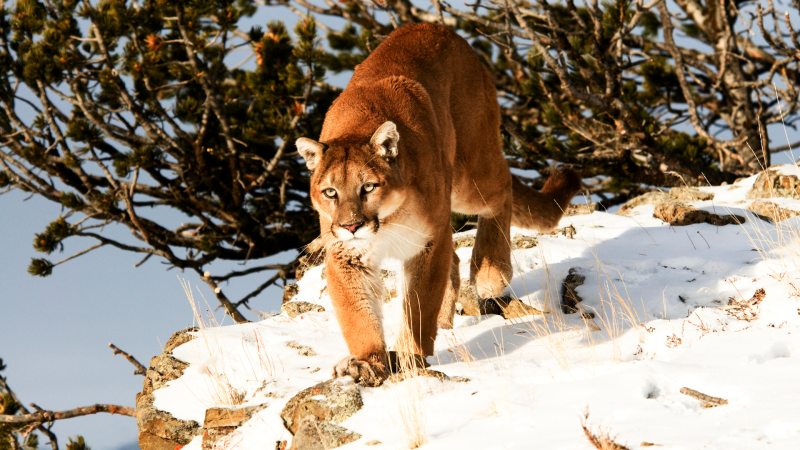Many often refer to mountain lions as cougars, pumas, and panthers. However, an encounter with one of these wild animals can be scary, no matter what you call it.
If you plan to spend time in their territory, you must know how to respond if you cross paths with one. Unfortunately, many people make a few mistakes that often increase the level of danger.
Today, we’re sharing helpful information and tips to avoid handling an encounter with a mountain lion the wrong way.
Let’s get started!
Where Do Mountain Lions Live in the United States?
Despite what most people think, mountain lions live in nearly a third of the states throughout the United States. The sixteen states with mountain lion populations include Arizona, California, Colorado, Florida, Idaho, Montana, Nebraska, Nevada, New Mexico, North Dakota, Oregon, South Dakota, Texas, Utah, Washington, and Wyoming.
Mountain lions have a widespread geography because they can adapt to their environment. They can thrive in mountains, forests, deserts, and grasslands. As a result, California, Colorado, Washington, and Montana have the largest populations of mountain lions in the United States.
Unfortunately, mountain lions are constantly on the move as their habitats are under attack by development. The destruction of their homes has led to increased interactions between humans and mountain lions.

How Common are Mountain Lion Encounters?
In most cases, encounters with mountain lions are extremely rare, and the likelihood of an attack is even smaller. According to the Mountain Lion Foundation, you’re more likely to drown in a bathtub, be hit by lightning, or be killed by a pet dog than a mountain lion. However, while the risk may be small, it’s not zero.
Like many animals, mountain lions often do their best to keep away from humans. They use their stealthy skills to creep through an area. If the massive cats hear or detect a human, they’ll generally leave the site.
Most encounters occur when the human interrupts the cat’s efforts to hunt for prey. As you might expect, they’ll quickly become aggressive or feel threatened in these situations. Their instincts will kick in, and they’ll defend themselves or the meal they were hunting.
HOT TIP
Be sure to read How to Survive a Bear Attack (Probably) before going on your next hike as we begin to enter hibernation season for bears!
The Wrong Way to Handle a Mountain Lion Encounter
You must know how to respond to increase the chances of safely escaping the situation. To prepare, you’ll want to familiarize yourself with several things you want to avoid doing when you encounter a mountain lion. Let’s take a look!
Running Away
One of the biggest mistakes you can make when interacting with a mountain lion is to run away. Doing so can trigger their hunting instincts, leading to you playing a very short game of tag with the animal. Not only are they nimble, but they’re capable of sprinting at speeds up to 50 miles per hour. We hate to tell you, but you won’t get very far.
Instead of running from the feline, you should slowly back away from the area. This can give the animal space and increase the distance between you and them. The more room you can create between you and the animal, the better.

Ignoring Signs of Aggression
Like most animals, mountain lions will give some warning signs to anything they perceive as a threat. These typically include hissing, growling, flattening their ears, and raised fur. If you witness a mountain lion behaving like this, it’s best to back away slowly.
Ignoring signs of aggression can escalate the situation and make things worse. It may even trigger defensive actions from the cat, which won’t end well for you. They’re quick, muscular creatures with teeth and claws that can do some severe damage.
Turning Your Back
When removing yourself from the situation, another wrong way to handle the encounter is to turn your back on the mountain lion. Much like running, this could spark the predatory instinct in the animal. This could cause them to chase you and hunt you down.
Instead, face the animal and maintain eye contact. You want to appear bold and confident, even though you may be scared to death. It’s also a good idea to yell from your belly so it’s as deep and aggressive sounding as possible. The goal is to appear as large as possible to intimidate the creature.
Bending Over or Crouching
If you encounter a mountain lion, another terrible thing you can do is to bend over or crouch down onto the ground. Again, you want to appear as big as possible and avoid appearing like prey. This is another thing that can cause the mountain lion to respond aggressively.
They may interpret your bending over and crouching as a sign of submission, which is the last thing you want. Remember, you want them to be afraid of you as much as you possibly can.
Approaching Cubs
Like most parents, mountain lions are very protective of their young. They won’t take too kindly to anyone, human or not, getting in between them and their cubs. Unfortunately, you could be hiking a trail and be completely unaware of what you’ve walked into.
You should stop in your tracks whenever you spot cubs of any species. This is mainly because the parents aren’t likely too far behind or are already watching you. One false step, and you could be on the receiving end of their parent’s two-inch claws.

Making Sudden Movements
Not only should you avoid turning your back or trying to run away, but you also want to avoid sudden movements. These actions are another behavior that can cause a mountain lion to start hunting you. Evolution has blessed these animals with incredible hunting skills; you won’t stand a chance of escaping.
While we understand the situation will be tense, you must remain calm. Quick movements could provoke an attack or startle the mountain lion. Back away slowly to separate yourself from the cat.
Not Reporting the Encounter
The final wrong way to handle a mountain lion encounter is not to report the incident. Wildlife officials have an essential job to keep the public and animals as safe as possible. By informing local rangers and wildlife authorities, they can take the necessary steps to help humans and wildlife to coexist.
They may increase signage to alert others of the potential dangers. However, in the most severe situations, officials may close or restrict access to an area. If an animal has repeated aggressive encounters, it could get relocated to a safer spot away from the public.

Handle a Mountain Lion Encounter the Right Way
Overall, the most important thing is that you stay safe while you’re enjoying the great outdoors. If you live in one of the many states with mountain lions, you must take the time to educate yourself on them. Knowing what you should and shouldn’t do is the first step to keeping yourself safe. You should also ensure you have any necessary tools or equipment.
If You Want the Latest Travel News, Join Our Mailing List
Don’t rely on biased RV industry news sources to keep you informed. Stick with Nomadic News. We publish articles and breaking stories that matter to you every weekday.










